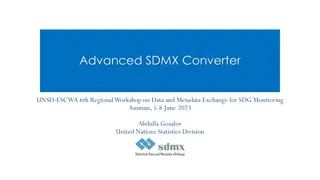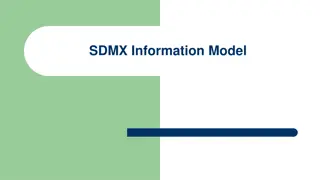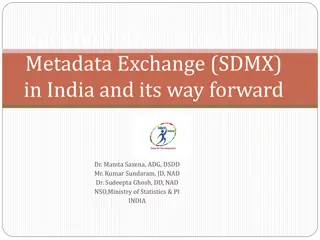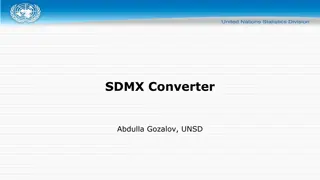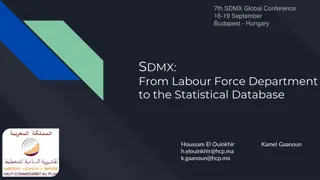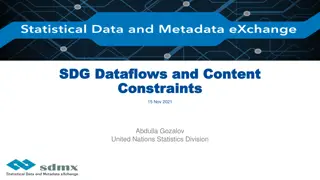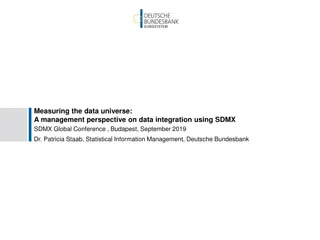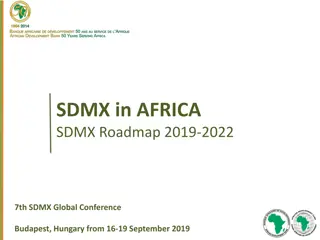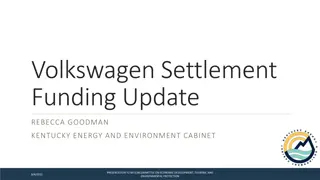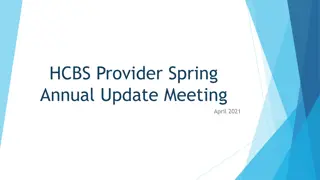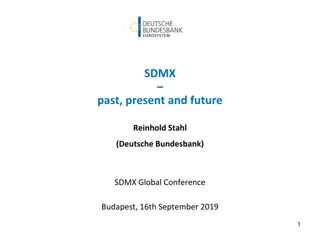
Data Structure Definitions in Statistical Data Management
Learn about Data Structure Definitions (DSDs) in statistical data management, including what they are, why they are essential for exchanging statistical information, and the collaboration involved in defining them. Dive into dimensions, attributes, measures, code lists, and more within the context of statistical data exchange and dissemination.
Download Presentation

Please find below an Image/Link to download the presentation.
The content on the website is provided AS IS for your information and personal use only. It may not be sold, licensed, or shared on other websites without obtaining consent from the author. If you encounter any issues during the download, it is possible that the publisher has removed the file from their server.
You are allowed to download the files provided on this website for personal or commercial use, subject to the condition that they are used lawfully. All files are the property of their respective owners.
The content on the website is provided AS IS for your information and personal use only. It may not be sold, licensed, or shared on other websites without obtaining consent from the author.
E N D
Presentation Transcript
United Nations Economic Commission for Europe Statistical Division Statistical Division United Nations Economic Commission for Europe International Recommendations for DSDs Development Steven Vale UNECE steven.vale@un.org
Introduction SDMX Governance What is a DSD? Code lists Guidelines Resources
SDMX Governance SDMX Sponsors SDMX Statistical Working Group Content-oriented guidelines SDMX Technical Working Group Technical specifications
What is a DSD? A Data Structure Definition is: A set of structural metadata associated to a Data Set, which includes information about how Concepts are associated with the Measures, Dimensions, and Attributes of a data cube, along with information about the Representation of data and related descriptive metadata SDMX Glossary v2.1 (December 2020): https://sdmx.org/wp-content/uploads/SDMX_Glossary_version_2_1-Final-2.docx
What is a DSD? To exchange or disseminate statistical information, an institution needs to specify which statistical concepts are necessary for identifying the series (and for use as Dimensions) and which statistical concepts are to be used as attributes and measures. These definitions form the Data Structure Definition The specification of the Data Structure Definition is often a collaborative venture between the collecting institution and its partners
What is a DSD? A standard way of describing the structure and contents of a data set
Dimensions, Attributes, Measures Dimensions Time Location Indicator Sex Age group Civil status .. Attributes Title Confidentiality status Other notes Data Set Measures Number of % of Ratio of
Code lists - CL_CIVIL_STATUS Recommended code Annotations values descriptions S M Single person This code includes persons who have never been married or in registered partnership. This code covers both persons living in a same-sex marriage as well as in an opposite-sex marriage. This code excludes legally separated persons. This code includes persons whose marriage ended with the death of the partner and who are not remarried or in a registered partnership. This code includes persons whose marriage ended with a divorce procedure and who are not remarried or in a registered partnership. This code includes persons who are separated: they are still married, but "officially" separated. . Married person Widowed person W Divorced person D Legally separated person L ..
Code lists - CL_CONF_STATUS Recommended code value F N C Recommended code description Free (free for publication) Not for publication, restricted for internal use only Confidential statistical information Secondary confidentiality set by the sender, not for publication Secondary confidentiality set and managed by the receiver, not for publication Primary confidentiality due to small counts Primary confidentiality due to dominance by one unit Primary confidentiality due to dominance by two units . D S A O T .
Where to find code lists Human readable SDMX website https://sdmx.org/?page_id=3215 Machine readable SDMX Global Registry https://registry.sdmx.org/overview.html
Creating code lists Guidelines for the Creation and Management of SDMX Code Lists https://sdmx.org/wp-content/uploads/SDMX_Guidelines_for_CDCL.docx Generic codes Used to cover residual information not contained in other categories of the code list (in some contexts, e.g. classifications, referred to as n.e.s., not elsewhere specified, n.e.c., not elsewhere classified, etc.) Used for expressing intermediate totals Other _O Subtotal _S Used for expressing totals Total _T Failure to obtain a measurement (e.g. non response, no data available, information not known by the respondent unit, etc.) No data/unknown _U
SDMX Content-Oriented Guidelines Cross-domain code lists Cross-domain concepts Statistical subject-matter domains Glossary https://sdmx.org/?page_id=4345
Other SDMX guidelines Guidelines on using SDMX Annotations Standardising Reference Metadata Reporting in SDMX Governance of commonly used SDMX metadata artefacts Modelling Statistical Domains in SDMX Guidelines for representing methodological changes in DSDs Guidelines for SDMX Data Structure Definitions Guidelines for the Creation and Management of SDMX Code Lists Guidelines on the Versioning of SDMX Artefacts Guidelines on Non-Calendar Year Reporting of Data Possible Ways of Implementing the Observation Status Concept Guidelines for Confidentiality and Embargo in SDMX Guidelines on coding time transformations in SDMX Guidelines for SDMX Concept Roles Checklist for SDMX Data Providers SDMX Global Registry Content Policy
Other SDMX guidelines Guidelines on using SDMX Annotations Standardising Reference Metadata Reporting in SDMX Governance of commonly used SDMX metadata artefacts Modelling Statistical Domains in SDMX Guidelines for representing methodological changes in DSDs Guidelines for SDMX Data Structure Definitions Guidelines for the Creation and Management of SDMX Code Lists Guidelines on the Versioning of SDMX Artefacts Guidelines on Non-Calendar Year Reporting of Data Possible Ways of Implementing the Observation Status Concept Guidelines for Confidentiality and Embargo in SDMX Guidelines on coding time transformations in SDMX Guidelines for SDMX Concept Roles Checklist for SDMX Data Providers SDMX Global Registry Content Policy
Guidelines for SDMX DSDs 1 Aim of this document 2 General design principles 3 Usage contexts 4 Data structuring approaches 5 Minimum structural and semantic requirements 6 Step-by-step guide 7 Annex 1. Glossary of Terms 8 Annex 2. What is a DSD? 9 Annex 3. References
Existing DSDs https://registry.sdmx.org/data/datastructure.html
Existing DSDs https://unstats.un.org/sdgs/iaeg-sdgs/sdmx-working-group/


